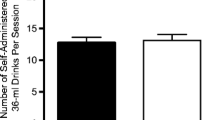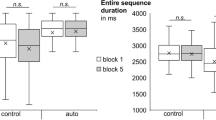Abstract
Three groups of male social drinkers were trained on a pursuit rotor task, and subsequently performed the task during five weekly drinking sessions under the same dose (0.83 ml absolute alcohol/kg). During sessions 1–4, group R (N=10) performed six trials on the task during rising blood-alcohol concentrations (BAC). Group F (N=10) performed the same number of trials at comparable falling BAC. Group C (N=5) received three trials at similar BAC during the rising and the falling portions of the alcohol curve. All groups displayed impaired performance on session 1. By session 4, tolerance was evident in groups C and F, but group R remained impaired. The consequences of these different practice treatments were examined in session 5, where all groups performed the task on the rising and the falling limb of the BAC curve. Groups C and F displayed tolerance on both limbs of the curve whereas the R group was impaired on both. Significant acute recovery was evident in the performance of groups F and R, but not in group C. The evidence was considered to support the hypothesis that a compensatory response, which is strengthened by practice, underlies acute recovery and tolerance.
Similar content being viewed by others
References
Beirness D (1983) Reinforcement contingencies control the development of behavioural tolerance in social drinkers. PhD thesis, University of Waterloo, Ontario, Canada
Chen CS (1968) A study of the alcohol-tolerance effect and the introduction of a new behavioural technique. Psychopharmacology 12:433–440
Goldberg L (1943) Quantitative studies on alcohol tolerance in man. Acta Physiol Scand (Suppl) 16:1–126
LeBlanc AE, Gibbins RJ, Kalant H (1975) Generalization of behaviourally augmented tolerance to ethanol, and its relation to physical dependence. Psychopharmacologia 44:241–246
Kalant H, LeBlanc AE, Gibbins RJ (1971) Tolerance to and dependence on ethanol. In: Israel Y, Mardones J (eds) Biological basis of alcoholism. Wiley-Interscience, New York, pp 235–270
Mann RE, Vogel-Sprott MD (1981) Control of alcohol tolerance by reinforcement in nonalcoholics. Psychopharmacology 75:315–320
Solomon RL (1980) The opponent-process theory of acquired motivation. Am Psychol 35:691–712
Vogel-Sprott MD (1979) Acute recovery and tolerance to low doses of alcohol. Psychopharmacology 61:287–291
Wenger JR, Tiffany TM, Bombardier C, Nicholls K, Woods SC (1981) Ethanol tolerance in the rat is learned. Science 213:575–576
Author information
Authors and Affiliations
Rights and permissions
About this article
Cite this article
Haubenreisser, T., Vogel-Sprott, M. Tolerance development in humans with task practice on different limbs of the blood-alcohol curve. Psychopharmacology 81, 350–353 (1983). https://doi.org/10.1007/BF00427576
Received:
Accepted:
Issue Date:
DOI: https://doi.org/10.1007/BF00427576




